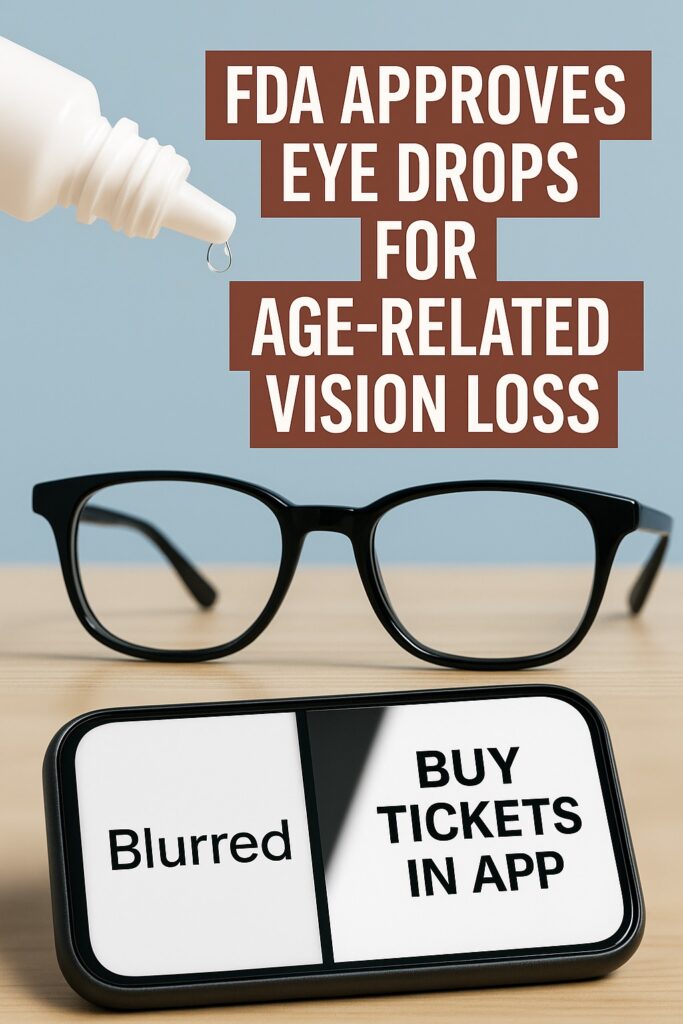By BaBazam Health Desk
The U.S. Food and Drug Administration (FDA) has approved VIZZ (aceclidine 1.44%), a once-daily prescription eye drop for presbyopia, also known as age-related near-vision loss. This condition affects over 128 million Americans and nearly 2 billion people worldwide, making it one of the most common age-related eye issues.
While it’s being billed as a breakthrough, VIZZ is actually the third pharmacologic treatment for presbyopia to receive FDA clearance — following Vuity in 2021 and Qlosi in 2023 — but it’s the first to use the drug aceclidine instead of pilocarpine.
What Is Presbyopia?
Presbyopia typically starts in the early-to-mid 40s, when the eye’s lens loses flexibility, making it harder to focus on close objects. Reading glasses are the traditional fix, but for many people, convenience and lifestyle are driving interest in alternative solutions.

How VIZZ Works
VIZZ is a miotic drop — it works by making the pupil smaller, creating a “pinhole camera” effect that increases depth of focus. This helps you read a menu, check your phone, or work on a laptop without needing to grab reading glasses.
- Onset: Around 30 minutes after use
- Duration: Up to 10 hours of improved near vision
- Dosing: One drop in each eye, wait 2 minutes, then a second drop from the same vial
- Storage: Single-dose vials; refrigeration required until opened
Safety and Side Effects
Like other miotic drops, VIZZ can cause:
- Temporary dim vision (especially in low light)
- Eye redness or mild irritation
- Headaches in some users
The FDA recommends a retinal exam before starting these drops, since rare cases of retinal detachment have been linked to similar medications. Patients should also be cautious with night driving after dosing.
How VIZZ Compares
| Feature | VIZZ (2025) | Vuity (2021) | Qlosi (2023) |
|---|---|---|---|
| Active ingredient | Aceclidine 1.44% | Pilocarpine 1.25% | Pilocarpine 0.4% |
| Dosing | Once daily (two drops per eye) | Once or twice daily | Once or twice daily |
| Duration | Up to 10 hrs | 6–9 hrs | Up to 8 hrs |
| Storage | Refrigerated vials | Room-temp bottle | Refrigerated vials |
The Market Potential
The market for presbyopia eye drops is still young but growing fast. Vuity’s launch showed there is strong interest — and also revealed challenges:
- Price: Most insurance plans don’t cover presbyopia drops; expect cash-pay pricing in the $100–$200/month range.
- Convenience: Refrigerated single-dose packaging can be less practical than a room-temperature bottle.
- Adoption: Likely to appeal most to people in their 40s–50s who want freedom from readers for social events, work meetings, and travel.
If just 2% of U.S. presbyopia patients adopted drops at ~$300/year, the market could reach $770M annually — and VIZZ is entering with a duration advantage that could sway users.
Looking Ahead
VIZZ is expected to roll out sample kits to doctors by October 2025, with broader pharmacy availability in late 2025. More options are coming, too — including BRIMOCHOL PF, now under FDA review, which combines two active ingredients to potentially extend wear time and reduce redness.
Bottom line: VIZZ gives eye-care professionals another tool to help patients delay or reduce dependence on reading glasses. But as with any new treatment, cost, convenience, and personal tolerance will determine whether it becomes a daily habit or an occasional luxury.









